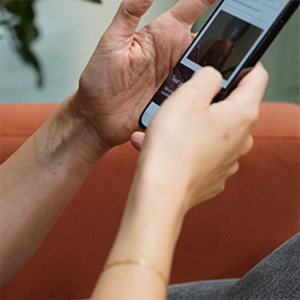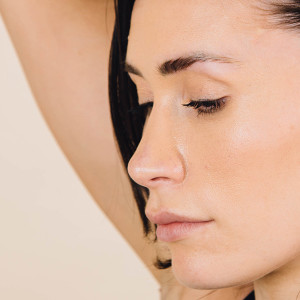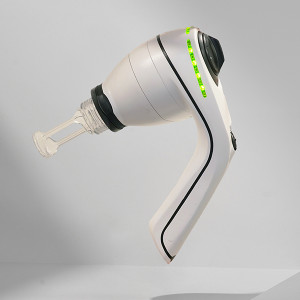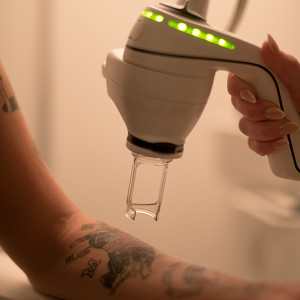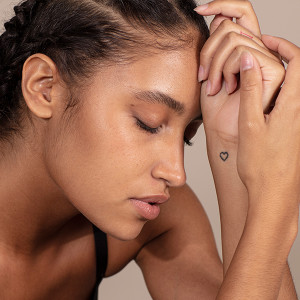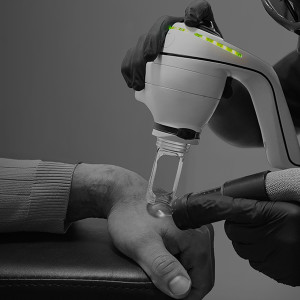
Tattoo removal side effects tend to be less common than they once were. Just in case, we checked in with the-best-of-the-best Dr Fiona Worsnop, consultant dermatologist at Stratum Dermatology Clinics, to find what to do if any tattoo removal side effects pop up.
Choosing a good quality tattoo removal studio is really important when it comes to your chances of side effects. Going with a studio that has certified consultants with expert training ensures your risk of encountering any is low (if non-existent) as they’ll be following protocol, checking in on the laser and ensuring you’re set up with the right aftercare before sending you home.
“Side effects are very uncommon,” says Dr Fiona. “You may have some redness or swelling around the area, and some people experience temporary changes to their skin’s pigment, but it's unlikely for the majority of people.” All of these can be significantly reduced if you follow your recommended aftercare.
Publish Date in article


Follow your tattoo removal aftercare (yes it makes a difference!)
Here’s what our team suggests:
- Keep the medical dressing applied to the skin on for a minimum of 72 hours
- You can shower, but avoid direct water pressure on the area for up to 72 hours. This is so you don’t rip the dressing. We recommend avoiding hot water, so no scolding showers, baths or hot tubs.
- Practice safe sun skincare and keep the area covered for a week after treatment. Then regularly apply sunscreen with high SPF and UVA 4*+ rating between your treatments and for the duration of your removal.
- Maintain a healthy lifestyle. Eat well, get 8 hours of sleep and drink lots of water.
Here’s what to do if you have any side effects
1. Itching
Apply aftercare cream to help soothe and hydrate after your tattoo removal session. We recommend NAAMA’s vegan skincare formulated with clean, plant-based ingredients to protect the skin, boost blood flow and help with cell turnover between removal treatments. Start with the Aftercare Cream for the first week after treatment while skin is still sensitive, then use the Regeneration Cream up until your next session.
Don’t pick or scratch the area as this will hinder the healing process. Refrain from wearing abrasive or tight clothing that might rub against the skin.
2. Redness
If you have sensitive skin, some redness and raising of the skin can be quite normal after treatment. If you’re experiencing any, it should go down within a few hours. Let the area be and keep your dressing on.
Don’t panic. If you just had treatment, it’s most likely superficial redness which is normal and should go down on its own.
3. Blisters
We’ve seen less than 1% of clients blister after treatment at NAAMA in the last year. That’s a testament to our LightSense™ laser system that uses controlled, lower energy pulses to effectively break down ink without causing permanent damage. As a result, the tissue is less likely to blister after treatment than older tattoo removal laser technologies.
Don’t pop the blister if one does happen to ‘pop’ up; instead leave it alone as much as possible. The blister acts as a biological dressing keeping the area clean. If your dressing remains intact and there is no fluid leaking, keep the dressing on for the full 72 hours post your treatment. This will prevent further fluid build up under the skin and keep the area protected.
If the dressing is coming away from the skin, gently soak the remainder off and dry the area. Once clean, apply our NAAMA Aftercare cream over the area to keep it hydrated and protected.


4. Hypopigmentation
Hypopigmentation is when the skin around the treated tattoo ends up looking a bit lighter in pigment than the rest. If you plan to go out in the sun, make sure you keep the treated area covered for a week after your appointment. Then regularly apply sunscreen with high SPF and UVA 4*+ rating between your treatments and for a month after. If hypopigmentation does occur, it is very likely that the pigment will be restored over time. The best thing to do is keep it protected from the sun to prevent further pigment change.
Don't skip the sunscreen.
5. Allergic reactions
“It’s very unlikely you'll have an allergic reaction to laser tattoo removal,” says Dr Fiona. “This happens only in rare cases and can occur when there has been a dormant infection in the treatment area.” If you’re worried give us a ring, send a text or email us and we’ll advise further if needed.
Don’t worry. Reach out to us, and we’ll be happy to sort you out. Your skin is our number one priority and no question is too silly to ask.

Pick our plant-based tattoo removal skincare formulated to help supercharge removal results at our NAAMA studio.


